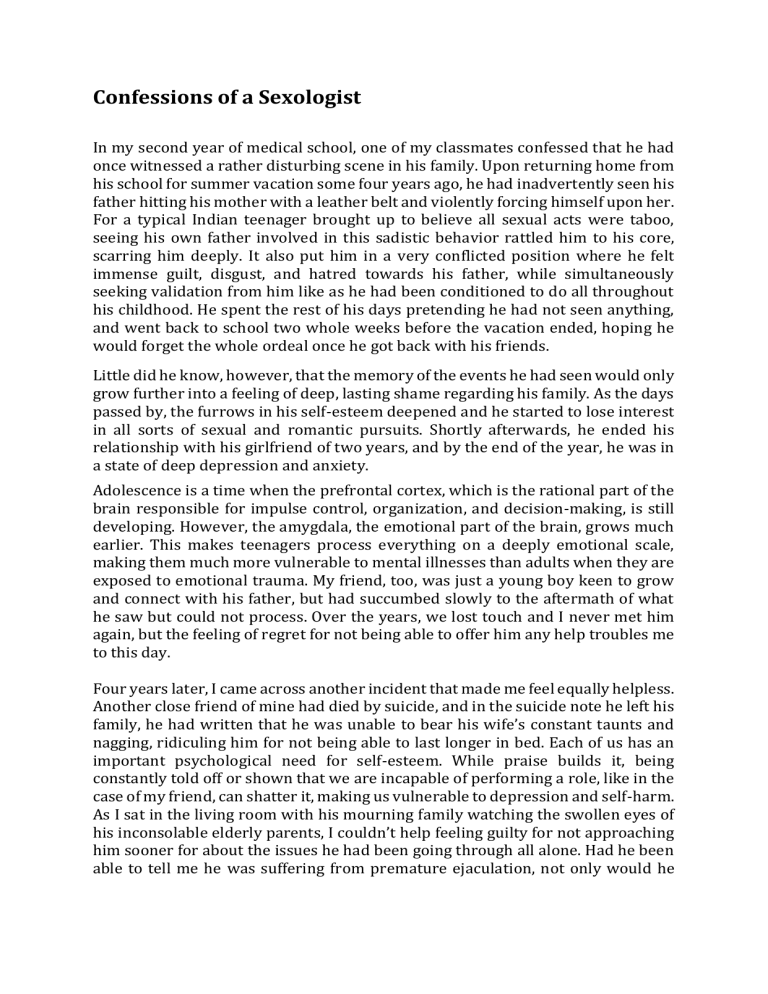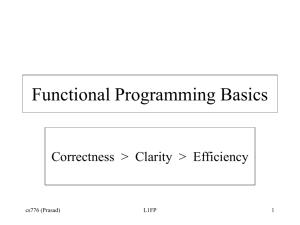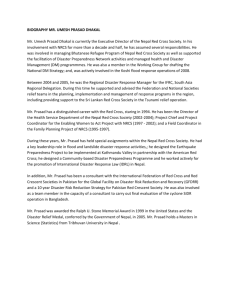
Confessions of a Sexologist In my second year of medical school, one of my classmates confessed that he had once witnessed a rather disturbing scene in his family. Upon returning home from his school for summer vacation some four years ago, he had inadvertently seen his father hitting his mother with a leather belt and violently forcing himself upon her. For a typical Indian teenager brought up to believe all sexual acts were taboo, seeing his own father involved in this sadistic behavior rattled him to his core, scarring him deeply. It also put him in a very conflicted position where he felt immense guilt, disgust, and hatred towards his father, while simultaneously seeking validation from him like as he had been conditioned to do all throughout his childhood. He spent the rest of his days pretending he had not seen anything, and went back to school two whole weeks before the vacation ended, hoping he would forget the whole ordeal once he got back with his friends. Little did he know, however, that the memory of the events he had seen would only grow further into a feeling of deep, lasting shame regarding his family. As the days passed by, the furrows in his self-esteem deepened and he started to lose interest in all sorts of sexual and romantic pursuits. Shortly afterwards, he ended his relationship with his girlfriend of two years, and by the end of the year, he was in a state of deep depression and anxiety. Adolescence is a time when the prefrontal cortex, which is the rational part of the brain responsible for impulse control, organization, and decision-making, is still developing. However, the amygdala, the emotional part of the brain, grows much earlier. This makes teenagers process everything on a deeply emotional scale, making them much more vulnerable to mental illnesses than adults when they are exposed to emotional trauma. My friend, too, was just a young boy keen to grow and connect with his father, but had succumbed slowly to the aftermath of what he saw but could not process. Over the years, we lost touch and I never met him again, but the feeling of regret for not being able to offer him any help troubles me to this day. Four years later, I came across another incident that made me feel equally helpless. Another close friend of mine had died by suicide, and in the suicide note he left his family, he had written that he was unable to bear his wife’s constant taunts and nagging, ridiculing him for not being able to last longer in bed. Each of us has an important psychological need for self-esteem. While praise builds it, being constantly told off or shown that we are incapable of performing a role, like in the case of my friend, can shatter it, making us vulnerable to depression and self-harm. As I sat in the living room with his mourning family watching the swollen eyes of his inconsolable elderly parents, I couldn’t help feeling guilty for not approaching him sooner for about the issues he had been going through all alone. Had he been able to tell me he was suffering from premature ejaculation, not only would he have been alive, but he would also have been able to enjoy a stronger and healthier relationship with his partner. These are, unfortunately, just two among many of these instances. In my years of working as a sexologist, I have become a prime witness of thousands of stories like these, all revolving around the pain that arose from unresolved issues connected to human sexuality, begging some very important questions as to why this has been happening, and what we can do to prevent it. *** Sex continues to be a big taboo in India. For all other matters concerning health, our society has ensured that there is help available in the form of proactive support structures with a range of treatment options. Research across various disciplines of medicines, too, has always been encouraged. When it comes to our most intimate desires, however, there is a dead silence, an awkwardness, and a sense of shifty avoidance. Most households gleefully pretend sex does not exist at all, and proper sex education is a rare privilege denied to many. This collective censorship has manifested into a paucity of understanding, treatment options, and support for victims of psychological and sexual ailments who fear societal ostracization merely for seeking help. As a practicing sexologist, I know that a vast majority of patients who visit a sexology clinic arrive to seek help with psychosexual issues, which often relate to the mental, emotional, and behavioral aspects of sexual development. To address this, we need dedicated experts working exclusively in this specialty, as is the case in many developed parts of the world. In countries like India where we need these experts the most, however, we still suffer from an extreme shortage of trained professionals. Things were even worse when I started working in the 80s, where when we had no clear directions, treatment options, or protocols for a wide range of psychosexual diseases. Even in the 90s, I often felt like I was on my own when it came to finding treatment methods. One of the most challenging cases I faced during this time was of Prasad, a 34-yearold man from Mumbai. On the outside, it seemed he had his life all figured out. He lived with his parents in a plush city apartment and ran a successful business. Although single, Prasad visualized himself as a father who could dote on his wife and nurture his children. As was often the case with many young people in India, his parents, too, were keen to see him married and have children. In fact, hHe had received several proposals from women, but to the surprise of his family, he had turned all of them down. “Doctor, I am not attracted to men or women, not even children or animals,” he told me when we met, pausing to check my reaction. Having visited many therapists in India and in the US without any results, he already knew the questions I might ask him, as well as the fact that his problem was not conventional. His facial expressions therefore, therefore, made no attempt to hide his reservations about therapy. “I am sexually aroused only when I caress or fondle an artificial male wig.” he added, “And before you ask me, please don’t misunderstand this for any sexual attraction to men who wear wigs.” Although he tried to appear tough on the outside, the mix of sadness and frustration in his eyes was impossible to miss when he said this. I knew I could not let him return empty empty-handed. As we talked further, it became clear to me that Prasad wasn’t entirely asexual. In his private moments, in fact, he would often fondle with one of his wigs to masturbate. I recogniszed and recognized the diagnosis the instant he gave me this information, but knowing he suffered from a severe form of fetishism wasn’t enough to help him. The real problem lay in the fact that there was no standard line of treatment for this condition, so the challenge for me was to not only help him get rid of his wig fetish, but to also ensure that his faith in therapy and therapists remained unharmed. Over the next few weeks, Prasad and I started unravelling this story further. When he was 12 years old, his daily routine involved going to school and returning by 2 in the afternoon. His parents only came home from work at around 7 in the evening, giving him about five hours of time alone, which he would spend watching cartoons or playing games by himself. This was routine for a few years until his maternal uncle came to stay with them for a few months. A single man in his thirties, his uncle wore a wig and had a particularly flamboyant air to him. Prasad soon found a friend in him and they started spending a lot of time together after school. From sharing snacks to helping Prasad with his homework, the uncle made him feel immensely safe and loved. Instead of an empty house, Prasad was now returning home excited to watch his favorite cartoons with someone who would be waiting for him. One day, on a hot summer afternoon, the uncle introduced Prasad to a new game. He insisted, however, to swear that the game would be kept a secret between the two of them, or else they could not play. In his naivety, Prasad gleefully agreed. The game would begin with the act of undressing, after which the uncle would ask Prasad to relax and lie down. He would then proceed to gently massage his body and slowly begin masturbating the boy. All that Prasad was expected to do was lie back and enjoy being pleasured by his uncle. Alone in the house for five hours, the game became an everyday affair. Afraid of speaking out and unaware of the meaning or significance of the assault, Prasad would uncomfortably look at his uncle's face and gradually shift his gaze to his wig. This made his young and impressionable mind form an association between wigs and sexual pleasure without him even realising realizing it. Eventually, it became a fetish that he did not register was unnatural. Soon, Prasad’s uncle received a job offer and moved to another country. Unfortunately, it had been too late for Prasad who had already developed a penchant for masturbation. He would return from school every day and visualize those moments with his uncle as he pleasured himself. As the years passed, the uncle’s face faded but the habit of gazing at the wig remained. Eventually, he reached a point where he could not get aroused and enjoy sexual release without using the fantasy of a male wig It took us several sessions and over four months of time to find this the source of his fixation. One of the key features of therapy for fetishism is finding the root of where it arises. It is a time-consuming and intricate job, but the arduous effort and patience eventually paid off, and Prasad managed to share the secrets he had unconsciously prohibited himself to revisit, let alone share with someone else. While this was a massive step in the right direction, what remained now was to cure Prasad of this condition, which I suspected was going to be even trickier. If Prasad had visited a psychiatric ward in the 1970s or even the 80s, he would have been given Electroconvulsive Shock Therapy (ECT), a controversial technique of passing electricity through the brain as a form of treatment. Contrary to popular beliefs, ECT is actually a tremendously useful technique proven to safely and successfully treat patients with uncomplicated but severe and prolonged depression, bipolar disorder, acute mania, and certain schizophrenic syndromes. In the 60s to 80s, there was a blatant misuse of this technology, with many physicians prescribing it as the first line of treatment to almost anyone including patients of with mild depression, anxiety, or even psychosis, for whom much simpler treatment options were available. ECT had become so popular by the 70s that many suspicious family members insisted that doctors give ECT to their patients, and some physicians even threatened patients with ECT. In fact, in the year 1981, when I completed my medical degree, ECTs were still being provided by obsolete machines operated by ignorant and uncaring psychiatrists. Even in the developed west back then, less than half the clinics met the minimum standard guidelines set by the Royal College of Psychiatrists. We can only imagine what the condition would have been like in India for Prasad. I knew, therefore, that I would have to go beyond what was established and innovate to help my patient. Before looking forward, however, I decided to take a look back at some past principles in psychotherapy that had been overshadowed by the rise of ECT and were no longer in popular use, hoping one of them would show some promise. I knew of a tool called Transactional Analysis (TA) that can be of a good use in Prasad’s case. TA is a unique method of therapy inspired by Sigmund Freud’s psychoanalysis and developed by a Canadian psychiatrist, Dr. Eric Berne. This technique requires exploring the interactions that the patient has had throughout the years with the people closest to him, and analyses analyzing this information to understand the inner mechanics of how his psyche is functioning and perceiving the world. Along with this, I employed a series of psychotherapeutic interventions such as Robert Carkhuff’s model of counseling, Rational Emotive Behaviour Therapy, and Gestalt therapy in my counseling sessions. These psychotherapeutic techniques are unique in the sense that they are targeted and personalized, which makes sense considering how every patient’s psychosexual issue has an intensely personal origin behind it. In many ways, they are far gentler and safer than ECT ensuring that millions can benefit from specialized therapy and live meaningful lives. As the weeks rolled away, Prasad slowly started showing improvement with these techniques, and only a year after starting the treatment, he was completely healthy again. Inspired by Prasad’s case, I have successfully used a combination of TA, Robert Carkhuff model, REBT, and Gestalt therapy in many other cases of fetishes and paraphilias since then. When I share with psychiatrists today how the use of counseling and a series of psychotherapeutic interventions helped Prasad ultimately get married and raise a child, they confess that they have never heard about any of these techniques developed and practiced since the 1950s. In fact, nNone of the counseling techniques I used, including Robert Carkhuff’s model, Rational Emotive Behavior Therapy, Gestalt therapy, and TA, are part of a medical or psychiatry curriculum at an undergraduate or graduate level, even today. As there are hardly any clinical trials on fetishism, this treatment is still based almost entirely on the experience between the therapist and patient in the clinic and scattered research conducted on it. It has therefore become especially important that we share our experiences as therapists to seek solutions, and understand how sometimes innovation means looking back at what we have already done and trying to see if there are loose ends whichthat, when connected, can provide us with new answers. In saying all this, I must admit that the real solution to Prasad’s conundrum did not begin with my quest to try something new. It began with my patient’s own determination and perseverance in standing up against unjust stereotypes and taboos. None of this would have been possible had Prasad not been bold enough to admit that something was wrong and seek treatment, risking immense judgement and isolation from the people around him. Therefore, in the field of sexual medicine, perhaps the greatest innovation we need is not just in technology, but in the minds of our patients and our society as well. Innovation scale 1970: Prasad would have believed that he was an outcast. Insensitivity from others, be it a professional therapist or friends, would reaffirm his negative beliefs, and Prasad wouldn't realize that he could be a loving father, a devoted lover, and a generous human being. ECT could be performed as well, though it would not produce any results. 2020: Therapy helps him realize, among many things, that he was not at fault and must now focus on taking care of himself. The sexologist would also derive immense confidence from a documentation of success stories with valuable therapy tips and techniques. 2070: Undergraduates and graduates in medicine will be trained in basic counseling techniques. They will relieve therapists from treating primary psychiatric disorders. This is likely to allow the sexologist treating Prasad to feel supported and less burdened.



